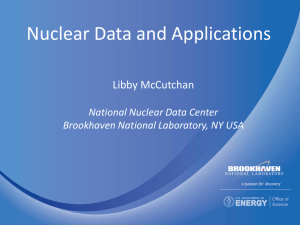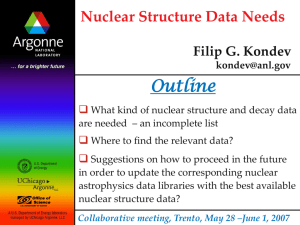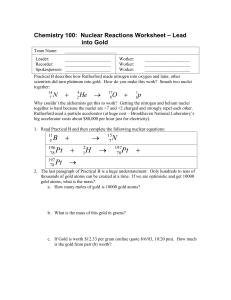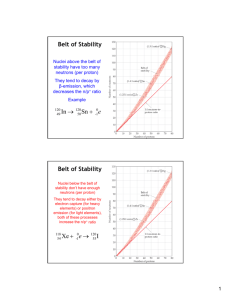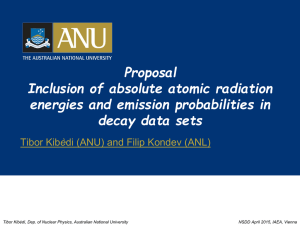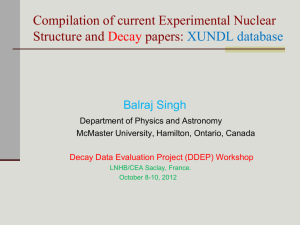Filip G. Kondev, Horizontal Evaluation on K
advertisement
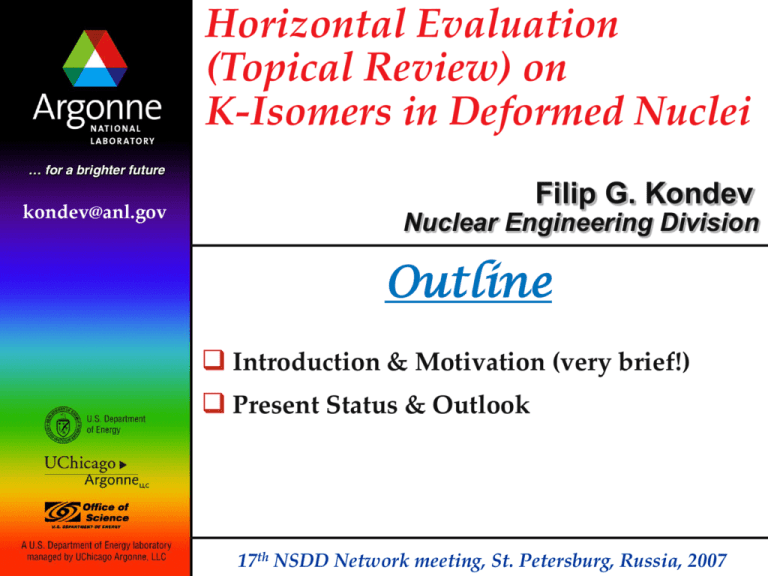
Horizontal Evaluation (Topical Review) on K-Isomers in Deformed Nuclei kondev@anl.gov Filip G. Kondev Nuclear Engineering Division Outline Introduction & Motivation (very brief!) Present Status & Outlook 17th NSDD Network meeting, St. Petersburg, Russia, 2007 Introduction & Motivation long-lived states due to conservation of the K quantum number w Kf=0 j 2 j1 j Ki Probe various aspects of nuclear structure at extreme conditions: interplay between intrinsic & collective motion limits of conservation of K-quantum number (robustness of symmetry) seniority dependence of major residual interactions in deformed nuclei Exotic nuclear structure studies: radioactive targets – high-spin/seniority – e.g. 178mHf, 177mLu radioactive beams – the future – physics at extreme conditions Potential for many applications: Astrophysics, Activation analysis; Medicine; Detector calibration standards; Nuclear energy 2 K Isomers: Where to find them? Deformed nuclei with axially-symmetric shape Mass 180 region : Yb (Z=70)-Ir(Z=77) w j2 j1 j K High-K orbitals near the Fermi surface 5/2[402], 7/2[404], 9/2[514] n 5/2[512], 7/2[514], 7/2[633], 9/2[624] 7-qp K=49/2 3 The Best Known Isomer … Jag has been always in an excited state! and he will have a very long lifetime! 4 Isomers Research at Argonne Availability of a variety of HI beams and a flexible beam pulsing system from 4He up to 238U/ time-range from ns up to years! Existence of high-efficiency detector systems, e.g. Gammasphere & FMA Studying Isomers at extreme conditions: Heavy nuclei/ Proton Drip Line/ Neutron Rich Nuclei/High-spin & Seniority 5 K-Isomers Evaluation Aim – to evaluate properties of all K-isomers in deformed nuclei – including Ex, K, J, T1/2, BR, ICC, B(XL) and fn - no such systematic study exists, but it is very much needed! Why not using ENSDF directly? we (in ENSDF) don’t treat explicitly the K-quantum number long updating time (6-8 years) (I,K)i (I,K)f Eg(Xl) for M1 and E2 decays 20< fn <100 - K-hindered decay fn<10 - anomalous decay fv>100 – perhaps something is wrong! n=DK-l – degree of K-forbiddenness F=tg(Xl)/tw(Xl) – hindrance factor fn=(F)1/n – reduced hindrance per degree of K-forbiddenness – gives yardstick for “goodness” of the Kquantum number 6 K-Isomers Evaluation-cont. The data are evaluated in ENSDF format have agreed on general policies – tried to follow the ENSDF policies as much as possible specialized codes were developed The evaluation will be completed in the next 1-2 years and it will be made available to all NSDD centers and published can easily be used to update ENSDF will make specific recommendations to improve ENSDF – introduction of the K-quantum number explicitly it will be continuously updated the need to include other classes of isomers – will depend on the needs of the community 7 K-Isomers Evaluation-cont. Prediction of energies, J – OK: WS (Nilsson) with pairing Prediction of T1/2? – not so good! 8 Collaborators T. Kibedi & G.D. Dracoulis Australian National University, Canberra, Australia Encouragement and advice from many colleagues: R. Janssens (ANL), P. Chowdhury (UML), P. Walker (U. Surrey), and others Supported by the Office of Nuclear Physics, U.S. DOE 9

